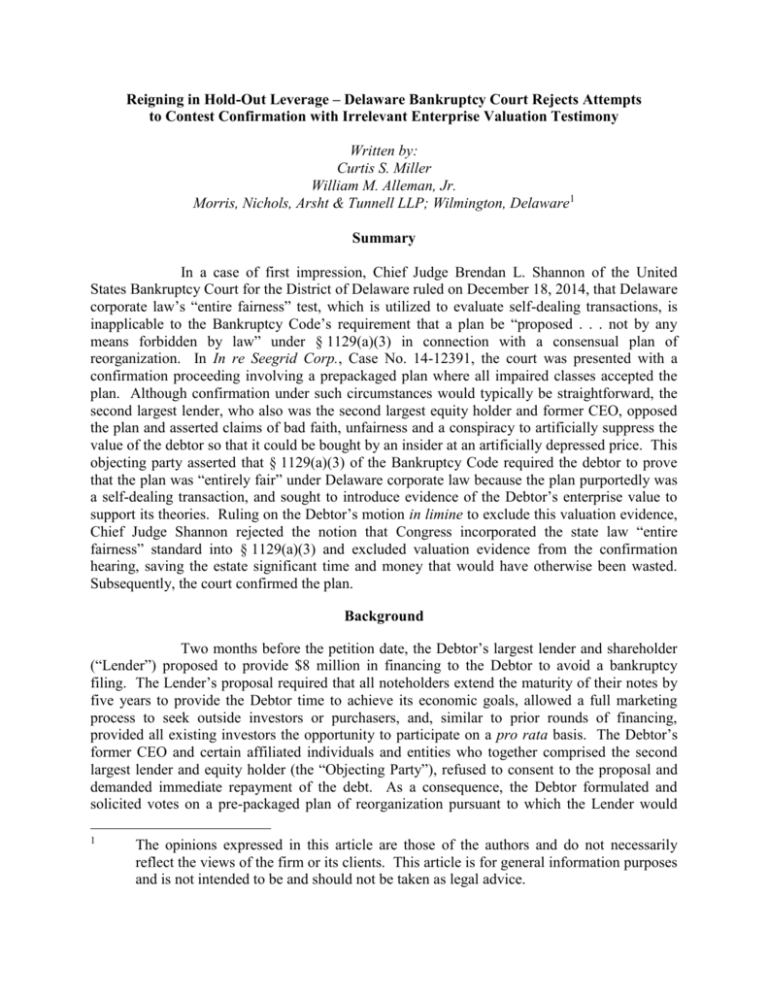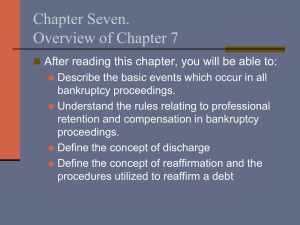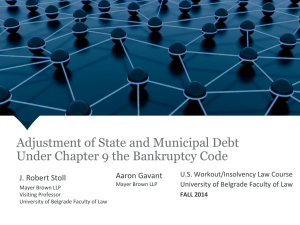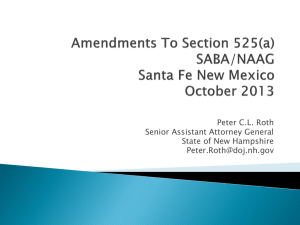Reigning in Hold-Out Leverage – Delaware Bankruptcy Court
advertisement

Reigning in Hold-Out Leverage – Delaware Bankruptcy Court Rejects Attempts to Contest Confirmation with Irrelevant Enterprise Valuation Testimony Written by: Curtis S. Miller William M. Alleman, Jr. Morris, Nichols, Arsht & Tunnell LLP; Wilmington, Delaware1 Summary In a case of first impression, Chief Judge Brendan L. Shannon of the United States Bankruptcy Court for the District of Delaware ruled on December 18, 2014, that Delaware corporate law’s “entire fairness” test, which is utilized to evaluate self-dealing transactions, is inapplicable to the Bankruptcy Code’s requirement that a plan be “proposed . . . not by any means forbidden by law” under § 1129(a)(3) in connection with a consensual plan of reorganization. In In re Seegrid Corp., Case No. 14-12391, the court was presented with a confirmation proceeding involving a prepackaged plan where all impaired classes accepted the plan. Although confirmation under such circumstances would typically be straightforward, the second largest lender, who also was the second largest equity holder and former CEO, opposed the plan and asserted claims of bad faith, unfairness and a conspiracy to artificially suppress the value of the debtor so that it could be bought by an insider at an artificially depressed price. This objecting party asserted that § 1129(a)(3) of the Bankruptcy Code required the debtor to prove that the plan was “entirely fair” under Delaware corporate law because the plan purportedly was a self-dealing transaction, and sought to introduce evidence of the Debtor’s enterprise value to support its theories. Ruling on the Debtor’s motion in limine to exclude this valuation evidence, Chief Judge Shannon rejected the notion that Congress incorporated the state law “entire fairness” standard into § 1129(a)(3) and excluded valuation evidence from the confirmation hearing, saving the estate significant time and money that would have otherwise been wasted. Subsequently, the court confirmed the plan. Background Two months before the petition date, the Debtor’s largest lender and shareholder (“Lender”) proposed to provide $8 million in financing to the Debtor to avoid a bankruptcy filing. The Lender’s proposal required that all noteholders extend the maturity of their notes by five years to provide the Debtor time to achieve its economic goals, allowed a full marketing process to seek outside investors or purchasers, and, similar to prior rounds of financing, provided all existing investors the opportunity to participate on a pro rata basis. The Debtor’s former CEO and certain affiliated individuals and entities who together comprised the second largest lender and equity holder (the “Objecting Party”), refused to consent to the proposal and demanded immediate repayment of the debt. As a consequence, the Debtor formulated and solicited votes on a pre-packaged plan of reorganization pursuant to which the Lender would 1 The opinions expressed in this article are those of the authors and do not necessarily reflect the views of the firm or its clients. This article is for general information purposes and is not intended to be and should not be taken as legal advice. contribute $10 million in return for 40% of the equity of a new entity that would own all of the Debtor’s assets. The Debtor filed for bankruptcy on October 21, 2014, after the conclusion of the pre-petition solicitation process that resulted in all voting classes accepting the plan. The bankruptcy court scheduled a confirmation hearing for December 10, 2014. Subsequently, the Objecting Party filed an emergency motion seeking to adjourn the confirmation hearing in order to conduct discovery, including with respect to enterprise valuation, which it contended would demonstrate that the Debtor’s plan improperly transferred control of the company to the Lender, an insider, for insufficient consideration. The Objecting Party argued that § 1129(a)(3) of the Bankruptcy Code, which requires that the plan be “proposed in good faith and not by any means forbidden by law,” incorporated Delaware corporate law’s “entire fairness” standard for reviewing self-dealing transactions, and thus enterprise valuation was necessary to establish that the plan transaction resulted in a “fair price.” In response, the Debtor filed a motion in limine requesting that the bankruptcy court exclude all evidence of enterprise value on several grounds. First, the Debtor argued that § 1129(a)(3)’s requirement that the plan be “proposed” in good faith and not by any means forbidden by law does not require the incorporation of all non-bankruptcy law, including Delaware corporate law’s “entire fairness” test, but only required that the bankruptcy court evaluate the manner in which the plan was formulated and presented to creditors. Second, the Debtor noted that the legislative history of § 1129(a)(3) made clear that although a debtor’s enterprise value will almost always be relevant in a cram-down plan when the court will be required to evaluate whether a plan is fair and equitable under § 1129(b), it is not required when a plan is confirmed under § 1129(a). Thus, the Objecting Party’s efforts to engage in an irrelevant contested valuation proceeding was entirely wasteful and unnecessary. Proposed in Good Faith and Not By Any Means Prohibited By Law Section 1129(a)(3) of the Bankruptcy Code provides that a bankruptcy court may only confirm a plan if “[t]he plan has been proposed in good faith and not by any means forbidden by law.”2 The purpose of section 1129(a)(3) is to promote a result consistent with the objectives and purposes of the Bankruptcy Code, namely, “preserving going concerns and maximizing property available to satisfy creditors” and, more generally, to give “debtors a fresh start in life,” “discourage debtor misconduct,” promote “the expeditious liquidation and distribution of the bankruptcy estate to its creditors” and “achiev[e] fundamental fairness and justice.”3 Courts have provided differing interpretations of section 1129(a)(3)’s requirement that the plan be proposed “not by any means forbidden by law.” Some courts have adopted an expansive reading of the provision, requiring that for a plan to be confirmed it must comply not 2 11 U.S.C. § 1129(a)(3). 3 In re Am. Capital Equip. LLC, 668 F.3d 145, 156-57 (3d Cir. 2012) (citations omitted); see also In re W.R. Grace & Co., 729 F.3d 332, 346 (3d Cir. 2013). 2 only with the requirements of section 1129, but also with all applicable non-bankruptcy laws, including Delaware corporate law requirements for the approval of self-dealing transactions. For example, one such case, In re Zenith Electronics Corp., held that “section 1129(a)(3) does incorporate Delaware law (as well as any other applicable nonbankruptcy law).”4 In Zenith Electronics Corp., minority shareholders of the debtor objected to the debtor’s pre-packaged plan of reorganization, pursuant to which the debtor’s largest shareholder and creditor would have received 100% of the equity of the reorganized debtor, arguing that § 1129(a)(3) requires compliance not only with the Bankruptcy Code, but also with Delaware corporate law and any other applicable non-bankruptcy law. The Zenith court agreed with the objectors that the plan proponents must comply with Delaware corporate law (and any other applicable non-bankruptcy law) but ultimately confirmed the plan after concluding that the plan satisfied the “entire fairness” test under Delaware corporate law.5 Other courts, however, have rejected the broad reading of section 1129(a)(3), opting to follow a more straightforward and literal interpretation of the statutory text. These courts have noted that section 1129(a) focuses on the manner in which a plan is “proposed,” not whether a plan complies with all aspects of non-bankruptcy law. 6 These courts also note that the broader reading of section 1129(a)(3) creates an impossible task for bankruptcy judges, requiring them to become roaming arbiters of any potential applicable law relevant to a debtor’s plan.7 4 In re Zenith Electronics Corp., 241 B.R. 92, 108 (Bankr. D. Del. 1999) (emphasis added). 5 Id.; see also In re Coram Healthcare Corp., 271 B.R. 228, 240-41 (Bankr. D. Del. 2001) (noting that Zenith held that § 1129(a)(3) “incorporated non-bankruptcy law such as Delaware corporate law,” and that the bankruptcy court was “required to determine whether the plan was ‘entirely fair’ because it dealt with a transaction between a company and its controlling shareholder”). 6 In re Charter Commc’ns. Inc., 419 B.R. 221, 261 (Bankr. S.D.N.Y. 2009), aff’d 691 F.3d 476 (2d Cir. 2012); see also Irving Tanning Co. v. Maine Superintendent of Ins., 496 B.R. 644, 660 (1st Cir. B.A.P. 2013) (“Section 1129(a)(3) focuses not on the terms of the plan and its means of implementation but on the manner in which the plan ‘has been proposed.’”); In re 431 W. Ponce De Leon LLC, 515 B.R. 660, 673 (Bankr. N.D. Ga. 2014) (“Courts addressing the issue have uniformly held that § 1129(a)(3) does not require that the contents of the plan ‘comply in all respects with the provisions of all nonbankruptcy laws and regulations. Instead, § 1129(a)(3) requires that only the plan’s proposal, as opposed to the contents of the plan, be in good faith and in compliance with all nonbankruptcy laws.’” (citations omitted)); In re Gen. Dev. Corp., 135 B.R. 1002, 1007 (Bankr. S.D. Fla. 1991) (same); In re Buttonwood Partners Ltd., 111 B.R. 57, 59 Bankr. S.D.N.Y. 1990) (same); In re Food City Inc., 110 B.R. 808, 812-13 (Bankr. W.D. Tex. 1990) (same). 7 See In re Food City Inc., 110 B.R. at 812 (stating that a broad interpretation of § 1129(a)(3) “would convert the bankruptcy judge into an ombudsman without portfolio, gratuitiously seeking out possible ‘illegalities’ in every plan. Such a role is both inimical 3 With respect to the requirement adopted by some courts that a plan satisfy Delaware corporate law’s “entire fairness” standard for self-interested transactions, and thus an enterprise valuation to evaluate whether a “fair price” has been obtained, the legislative history of § 1129(a)(3) appears to reject this interpretation of the statute. Section 1129(a)(3)’s legislative history provides that although “a valuation will almost always be required under section 1129(b) in order to determine the value of the consideration to be distributed under the plan,” “section 1129(a) does not contemplate a valuation of the debtor’s business.” 8 Thus, adding a corporate law standard of review that requires an enterprise valuation to confirm a plan (i.e., the entire fairness standard) would seemingly contravene Congress’s intent to simplify the requirements for confirmation of a plan under § 1129(a). The Bankruptcy Court’s Ruling in Seegrid After briefing and oral argument, Chief Judge Shannon granted the Debtor’s motion in limine and excluded all evidence of enterprise valuation from the confirmation hearing. The court stated that “[a]t bottom, I am not satisfied that the Bankruptcy Code or relevant case law requires me to evaluate the proposed plan under the entire fairness standard.”9 The court’s analysis focused on whether the plan had been “proposed” in good faith as that term is used in § 1129(a)(3) of the Bankruptcy Code. Looking to the Third Circuit’s guidance in In re W.R. Grace, 729 F.3d 332, 346 (3d Cir. 2013), the court stated that “the scope of the Court’s inquiry into good faith, in particular, focuses on the plan process, and also whether the plan comports with the objective and purposes underlying the Code, not necessarily, does this plan comply in its implementation with the entire fairness standard under Delaware corporate law.”10 The court found that to incorporate the “entire fairness” standard into § 1129(a)(3) would import into the Bankruptcy Code a new standard of review to protect dissenting creditors in plans that are otherwise fully consensual, “[a]nd I do not agree that Congress intended to grant creditors such additional protections.”11 The court went on to find that “there is no other basis in 1129(a) to allow evidence on the debtor’s enterprise value in this case. The proposed plan has been voted on and accepted by all classes of creditor; and, thus, Section 1129(a) is the governing confirmation standard.”12 Finally, the court distinguished Judge Walrath’s arguably contrary ruling in Zenith on the grounds that the plan in Zenith was a cram-down plan governed by § 1129(b), and respectfully disagreed with Zenith to the extent that it stands for the proposition that § 1129(a)(3) to the basic function of bankruptcy judges in bankruptcy proceedings and a thoroughly unnecessary gloss on the statute.”). 8 H.R. Rep. No. 595, 95th Cong., 1st Sess. 414 (1977), 1978 U.S.C.C.A.N. 5787, 6370. 9 Tr. of Dec. 18, 2014, Hrg. at 4:17-19. 10 Id. at 6:20-25. 11 Id. at 6:6-8. 12 Id. at 7:21-25. 4 of the Bankruptcy Code incorporates all of Delaware corporate law. Objecting Party’s citation to Zenith, Judge Shannon stated as follows: In considering the First, I think Zenith is clearly distinguishable as a threshold matter from this case because the plan before the Court in Zenith was a cram-down plan, and was evaluated by the Court under Section 1129(b). The parties here, I believe, agree that valuation evidence would, indeed, be relevant in a cram-down context of 1129(b), because of the fair and equitable test under 1129(b). Here, no one disputes that Section 1129(a) governs the plan process in this case. And under 1129(a), the fair and equitable test has no application. The protections afforded by creditors by Congress under 1129(a) is limited to the liquidation value, as provided under 1129(a)(7). Accordingly, to the extent that the Zenith decision stands for the proposition that 1129(a)(3) embodies all of Delaware corporate law, and I’m not certain that it does, but if it does, I respectfully disagree.13 Accordingly, Judge Shannon granted the Debtor’s motion in limine and, following a subsequent evidentiary hearing, confirmed the Debtor’s plan of reorganization. The Importance of the Bankruptcy Court’s Ruling The Court’s exclusion of enterprise valuation evidence is a significant ruling for debtors and plan proponents as it enables debtors to avoid what could be prohibitively expensive litigation by hold-out creditors or shareholders and prevents the uncertainty that would arise if every debtor were faced with the obligation of proving that a plan satisfied all provisions of applicable non-bankruptcy law to confirm a plan. The Court’s granting of the motion in limine also provides the proper incentives to debtors and plan sponsors, encouraging them to construct a truly consensual plan with its creditors—which is the ultimate objective of chapter 11. 13 Id. at 7:4-20. 5






